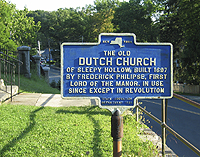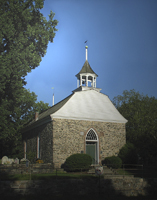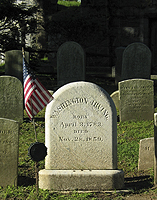| |
Click
to enlarge photo of the sign at the Old Dutch Church at Sleepy Hollow.

The sign reads:
"The Old
DUTCH CHURCH
Of Sleepy Hollow, Built 1697
By Frederick Philipse, First
Lord of the Manor. In Use
Since Except in Revolution"
Sleepy Hollow Cemetery
surrounds the Old Dutch Burying Ground and Old Dutch Church, but neither is affiliated with the cemetery. Washington Irving himself is laid to rest at the south end of Sleepy Hollow Cemetery overlooking the grounds of the Old Dutch Church.
Sleepy Hollow Cemetery is 85 acres in size, has over 40,000 in-ground interments, and a new community mausoleum. With the opening of the “Riverview Natural Burial Grounds”, Sleepy Hollow Cemetery has become one of a very small number of burial places in the country that provide a green burial option.
As the villages of Tarrytown and North Tarrytown were growing and additional burial space was needed, Washington Irving and Captain Jacob Storm originated the idea for the Sleepy Hollow Cemetery, officially opened in 1849.
Click blue button
for more information about the Sleepy Hollow Cemetery.
Click
to enlarge photo of the Old Dutch Church at Sleepy Hollow.

The Old Dutch Church
"It stands on a knoll, surrounded by locust-trees and lofty elms, from among which its decent whitewashed walls shine modestly forth, like Christian purity beaming through the shades of retirement. A gentle slope descends from it to a silver sheet of water, bordered by high trees, between which, peeps may be caught at the blue hills of the Hudson." Washington Irving in "The Legend of Sleepy Hollow."
Built in 1685, this is the oldest church standing in New York State. Made of stone and hand-hewn lumber, the church is built in a style typical of the northern Netherlands. Surrounding the Old Dutch Church is Sleepy Hollow Cemetery, immortalized in "The Legend of Sleepy Hollow".
"Philipse built his church on a grassy knoll about 200 yards from his manor house and gristmill, on a site long used as a burial ground. Constructed of fieldstone, local timber and flat, yellow bricks from Holland, the church is simple in architecture: octagonal at one end, with a Dutch gambrel roof and a belfry. The white-washed walls were fortress-like more than two feet thick. Small, rectangular windows were placed high in the walls.
"When the congregation was officially organized in 1697, its first pastoral call went out to Dominie Guiliam Bertholf, a well-known Dutch Reformed minister. He consented to come over three or four times a year from his home in Hackensack to preach and administer the sacraments. The rest of the year, services were led by lay clergy." Source:
Friends of the Old Dutch Church & Burying Ground
Click
to enlarge photo of Washington Irving's Gravestone.

Visit the grave of Washington Irving, who is considered by many to be the first internationally acclaimed author. Irving advocated for writing as a legitimate and respected profession, and successfully campaigned for copyright laws to protect American writers from copyright infringement. His first book, Salmagundi (1807–08), was a collaboration with his brother William and a mutual friend James Paulding. This highly popular collection of short pieces poked fun at the political, social, and cultural life of the city.
The gravestone reads:
WASHINGTON IRVING
,
BORN
April 3, 1783,
DIED
Nov. 28, 1859
Washington Irving
Washington Irving is best known for his fictional works, including a collection of 34 essays and short stories written during his stay in England. This work became known as
The Sketch Book of Geoffrey Crayon, Gent
and included the short stories "Rip Van Winkle" and "The Legend of Sleepy Hollow". Washington Irving also wrote several biographies and historical writings. After leaving England, Irving spent most of his time at his Sunnyside estate in Tarrytown, New York where he died on November 28, 1859.
Historic Sites in Sleepy Hollow and Tarrytown
Visit
Kykuit, the Rockefeller Estate in Sleepy Hollow.
Visit
Lyndhurst in Tarrytown.
Visit
Patriots Park in Tarrytown.
Visit the
Sleepy Hollow Lighthouse. Learn how a family lived and protected ships on the Hudson River.
Visit Historic Sunnyside
Washington Irving's home at Sunnyside
Children's Attractions in Sleepy Hollow and Tarrytown
Enjoy Family Fun Day at
Lyndhurst Historic Site in Tarrytown.
Learn about a spy in the
American Revolution - John André.
Visit
Patriots Park in Tarrytown.
Visit Historic
Philipsburg Manor Historic Site for kids.
Visit Historic Sunnyside,
Washington Irving's home in Tarrytown, offering games and activities for kids.
Visit
Sleepy Hollow Lighthouse. Learn how families lived while protecting boats on the Hudson River.
Celebrate
Halloween in Sleepy Hollow.
Celebrate
The Legend of Sleepy Hollow.
Spooky fun things to do on Halloween include a
Tour the Old Dutch Church & Burying Ground
Visit the Old Dutch Church & Burying Ground and find places mentioned in The Legend of Sleepy Hollow where "The dominant spirit, however, that haunts this enchanted region, and seems to be commander-in-chief of all the powers of the air, is the apparition of a figure on horseback, without a head. It is said by some to be the ghost of a Hessian trooper, whose head had been carried away by a cannon-ball, in some nameless battle during the Revolutionary War, and who is ever and anon seen by the country folk hurrying along in the gloom of night, as if on the wings of the wind. His haunts are not confined to the valley, but extend at times to the adjacent roads, and especially to the vicinity of a church at no great distance. Indeed, certain of the most authentic historians of those parts, who have been careful in collecting and collating the floating facts concerning this spectre, allege that the body of the trooper having been buried in the churchyard, the ghost rides forth to the scene of battle in nightly quest of his head, and that the rushing speed with which he sometimes passes along the Hollow, like a midnight blast, is owing to his being belated, and in a hurry to get back to the churchyard before daybreak."
"The Legend of Sleepy Hollow"
by Washington Irving
Location: Sleepy Hollow
|







